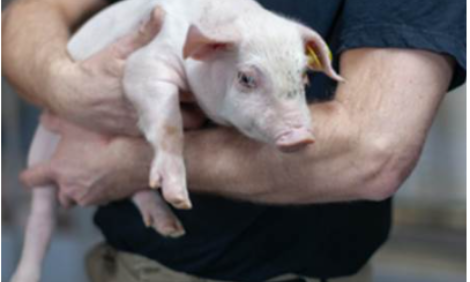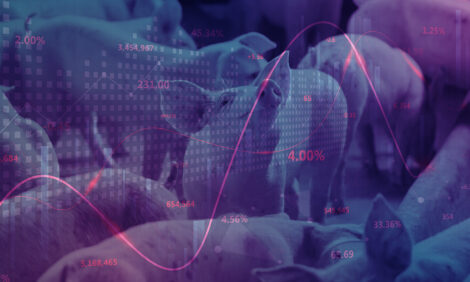



USDA Quarterly Pigs and Hogs Report: December 2004
This quarter's quarterly Hogs and Pigs report from the USDA's National Agricultural Statistics Service. The article provides the report text and graphs, and helps explain what it all means. Link also to the full PDF report.Introduction
This document aims to pull together, in one place of reference, all the various information generated by the USDA Quarterly report. This document includes:
USDA Quarterly report: December 2004What it all means
Graph data from the report Hog Inventories by State (external link - select State and navigate to file)
For a PRINTABLE VERSION of the full 24 page report in PDF format, including all the tabular data which is not shown in this article, Click Here
US Quarterly Pigs and Hogs Inventory: December 2004
U.S. inventory of all hogs and pigs on December 1, 2004 was 60.5 million head. This was up slightly from December 1, 2003, but down 1 percent from September 1, 2004.
Breeding inventory, at 5.97 million head, was down 1 percent from December 1, 2003, but up slightly from from last quarter. Market hog inventory, at 54.5 million head, was up slightly from last year, but 2 percent below last quarter.
The September-November 2004 U.S. pig crop, at 25.6 million head, was up slightly from 2003 and up 2 percent from 2002. Sows farrowing during this period totaled 2.85 million head, down slightly from last year. The sows farrowed during this quarter represented 48 percent of the breeding herd. The average pigs saved per litter was 8.96 for the September-November period, compared to 8.93 last year. Pigs saved per litter by size of operation ranged from 7.50 for operations with 1-99 hogs to 9.10 for operations with more than 5,000 hogs and pigs.
US Quarterly Pigs and Hogs Inventory: September 1

U.S. hog producers intend to have 2.86 million sows farrow during the December 2004-February 2005 quarter, 1 percent above the actual farrows during the same period in 2004, and 3 percent above 2003. Intended farrowings for March-May 2005, at 2.87 million sows, are down slightly from the same period in 2004, and down 1 percent from the same period in 2003.
The total number of hogs under contract, owned by operations with over 5,000 head, but raised by contractees, accounted for 38 percent of the total U.S. hog inventory, up from 35 percent last year.
Revisions
All inventory and pig crop estimates for March 2003 through September 2004 were reviewed using final pig crop, official slaughter, death loss and updated import and export data. Based on the findings of this review, small revisions, not exceeding one-half of one percent were made to the June 2004 total inventory, March-May 2004 pig crop, December-February 2004 pig crop, September-November 2003 pig crop, June-August 2003 pig crop and the September 2003 total inventory. Adjustments of less than one-tenth of one percent were made to the remaining quarters.
What it all means?
What the commentators and industry thinkers read into this data:
| Professor John Lawrence, Iowa State University December Hog and Pig Report Summary The USDA released its estimate of hog and pig inventories as of December 1, 2004. The domestic inventory of all hogs is approximately unchanged from one year ago at 60.5 million head (Table 1). Breeding herd numbers were down 0.7% from December 1 of last year. The market hog inventory was 54.5 million, up 0.2%. The estimated September-November pig crop is up 0.3% from a year ago. Farrowing intentions are up 0.7% for December-February, steady for March-May. The USDA numbers are generally lower than the pre-report estimates from the trade and should be bullish for prices. The only classes that were higher than the trade estimates were the 60-119 and 120-179 pound weight classes. These hogs will make up the bulk of the first quarter slaughter. It is interesting to note that the September report indicated an increase in the breeding herd, but it is estimated to be lower in December. Given the profits made by producers in 2004 we would expect expansion to be starting, but for now the industry appears to be sitting patiently and enjoying the black ink. Iowa producers increased inventories of breeding herd and market hogs 1% over December 2003. This added 10,000 animals to the breeding herd and 190,000 market hogs. The total inventory is 16.1 million head, up 1% from the year before and near the record inventory of 16.3 million head in 1981. The 15.03 million market hogs is a record high for Iowa. Interestingly, the December 2003 Iowa breeding herd of 1.06 million was a record low inventory for modern history. Continue reading this report here (PDF document) |
| Professor Mike Brumm, University of Nebraska December 2004 USDA Hogs and Pigs Report Commentary Many analysts have already commented on USDA upwards revisions to the June 1, 2004 inventory in Minnesota, Iowa and North Carolina. Of course, this upwards revision, plus the growth plans in the September 1 report are a reflection of the profitable state of today’s US pork industry. Unfortunately, Nebraska continues to decline in pig numbers relative to the US. All pigs kept for market in Nebraska totaled 2.49 million, the same inventory as in the June 1 report. However, Nebraska’s share of the US kept for market inventory declined slightly to 4.49%, another low not seen in Nebraska since the 1960’s. The breeding herd inventory was also stable at 360 thousand head, or 6.02% of the US total. Continue reading this report here |
| Ron Plain and Glenn Grimes Hogs and Pigs Report - December 2004 The December Hogs and Pigs report came in more positive than the trade estimates. The USDA estimate of all hogs and pigs on farms December 1 (100% of a year earlier) was about 1 1/2% smaller than the average of the trade estimates. The breeding herd at a little over 99% of 2003 was nearly 2% below the trade estimates and the market herd at about 100% of a year ago was also about 1 1/2% below the trade estimates (Table 1). The report was about 1% below our estimates on all three categories. The breeding herd came in at 99.3% of the 2003 number, and sow and gilt slaughter came in at almost exactly even with the USDA 2003 estimate. We never argue with a 1% difference. Both estimates have a potentially higher sampling error than 1%. Continue reading this report here |
| Chris Hurt, Purdue University Chris Hurt Hog producers across the country say they have not expanded the breeding herd yet, and that they will keep farrowings at about a constant level in coming months. The latest Hogs and Pigs report from USDA revealed that the breeding herd in the U.S. was down slightly from a year earlier, and that farrowing intentions for this winter and coming spring would be about unchanged as well, says Chris Hurt in his review of the Quarterly Hogs and Pigs report. Continue reading this report here |
Graph Data from the Report
US Quarterly Litter Rate: September - November

US Pigs Per Litter
By Size of Operation: Sep - Nov 2004

US Quarterly Sows Farrowed
Sep - Nov

US Quarterly Pig Crop: Sep - Nov

December 1 Hog Inventory and Market Hogs (US)

March 1 Hog Inventory and Market Hogs (US)

June 1 Hog Inventory and Market Hogs (US)

September 1 Hog Inventory and Market Hogs (US)

Reliability of December 1 Hogs and Pigs Estimates
Survey Procedures: A random sample of roughly 13,500 U.S. producers was surveyed to provide data for these estimates. Survey procedures ensured that all hog and pig producers, regardless of size, had a chance to be included in the survey. Large producers were sampled more heavily than small operations. Data were collected from about 11,000 operations, 82 percent of the total sample, during the first-half of December by mail, telephone, and face-to-face personal interviews. Regardless of when operations responded, they were asked to report inventories as of December 1.
Estimation Procedures: These hogs and pigs estimates were prepared by the Agricultural Statistics Board after reviewing recommendations and analysis submitted by each State office. National and State survey data were reviewed for reasonableness with each other and with estimates from past years using a balance sheet. The balance sheet begins with the previous inventory estimate, adds the estimates of births and imports, and subtracts the estimates of slaughter, exports, and deaths. This indicated ending inventory level is compared to the Agricultural Statistics Board estimate for reasonableness.
Revision Policy: Revisions to previous estimates are made to improve quarter to quarter relationships. Estimates for the previous four quarters are subject to revision when current estimates are made. In December, estimates for all quarters of the current and previous year are reviewed. The reviews are primarily based on hog check-off receipts and slaughter. Estimates will also be reviewed after data from the Department of Agriculture five-year Census of Agriculture are available. No revisions will be made after that date.
Reliability: Since all operations raising hogs are not included in the sample, survey estimates are subject to sampling variability. Survey results are also subject to non-sampling errors such as omissions, duplication, and mistakes in reporting, recording, and processing the data. The affects of these errors cannot be measured directly. They are minimized through rigid quality controls in the data collection process and through a careful review of all reported data for consistency and reasonableness.
To assist users in evaluating the reliability of the estimates in this report, the "Root Mean Square Error" is shown for selected items in the following table. The "Root Mean Square Error" is a statistical measure based on past performance and is computed using the difference between first and final estimates. The "Root Mean Square Error" for hog inventory estimates over the past 20 quarters is 1.2 percent. This means that chances are 2 out of 3 that the final estimate will not be above or below the current estimate of 60.5 million head by more than 1.2 percent. Chances are 9 out of 10 that the difference will not exceed 2.0 percent.








